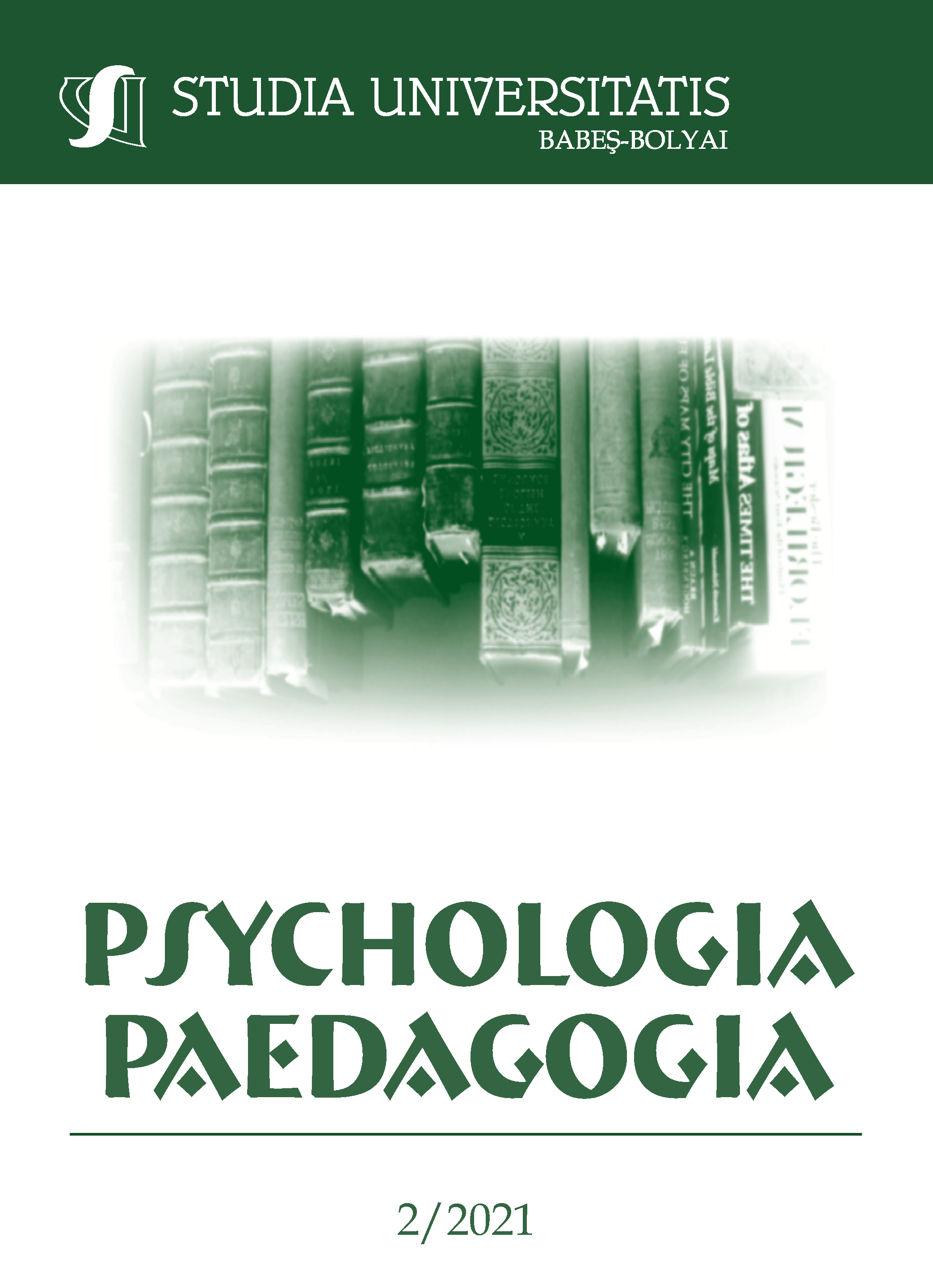FOSTERING SCHOOL ENGAGEMENT IN CHILDREN FROM DISADVANTAGED COMMUNITIES
DOI:
https://doi.org/10.24193/subbpsyped.2021.2.02Keywords:
school dropout, school engagement, social and emotional competencies, disad-vantaged communitiesAbstract
In the last two decades, most of the Romanian mitigate programs aimed at reduc-ing school dropout, have often focused only on remedial activities. However, keeping students in school for as long as possible involves increasing their school engagement, and therefore developing dimensions that target social and emo-tional skills is strongly recommended. In the present study, 130 primary and sec-ondary school students from disadvantaged backgrounds, participated for 8 months in remedial and personal development activities, whose medium-term goal is to reduce school dropout. Using scales from the BASC and ASEBA psy-chological test batteries, we were able to capture significant effects of the inter-vention in reducing emotional problems and increasing students' adaptability to school-specific tasks, even though the pandemic imposed several restrictions on activities. The collected data revealed two important outcomes. First, they con-firmed the effectiveness of a complex, multilevel program, which can develop the socio-emotional abilities of children at risk of dropping out of school. Second, they help us to highlight several factors that can predict its effectiveness. We con-sider that these empirical data constitute a solid foundation based on which simi-lar future programs can be designed and implemented.References
Archambault, I., Janosz, M., Fallu, J. S., & Pagani, L. S. (2009). Student engagement and its relationship with early high school dropout. Journal of Adolescence, 32, 651-670. https://doi.org/10.1016/j.adolescence.2008.06.007
Benga, O., Buzgar., R, Dumulescu, D., Opre, A., Pintea, S., (2018), Analiza practicilor psiho-educationale privind dezvoltarea abilitatilor non-cognitive la copii si adolescenti, Bucuresti, Ed. Alpha MDN, ISBN 978-973-139-393-3
Brown, B. B. (2004). Adolescents’ relationships with peers. In R. M. Lerner, & L. Steinberg (Eds.), Handbook of adolescent psychology (pp. 363394). New York: Wiley. Avail-able from https://doi.org/10.1002/9780471726746.ch12
Buzgar, R., Dumulescu, D., Opre, A., (2013). Emotional and Social Problems in Primary School Children: a National Screening Program, PSIWORLD 2012, Procedia - Social and Behavioral Sciences, 78, 250-254
DiPerna, J. C., Volpe, R. J., & Elliott, S. N. (2002). A model of academic enablers and elemen-tary reading/language arts achievement. School Psychology Review, 31(3), 298-312.
Domitrovich C.E, Durlak J.A, Staley K.C, Weissberg R.P. (2017). Social-Emotional Compe-tence: An Essential Factor for Promoting Positive Adjustment and Reducing Risk in School Children. Child Development, 88(2):408-416. doi: 10.1111/cdev.12739.
Fredricks, J. A., Blumenfeld, P. C., & Paris, A. H. (2004). School engagement: Potential of the concept, state of the evidence. Review of Educational Research, 74(1), 59- 109. Available from https://doi.org/10.3102/00346543074001059.
Furrer, C., & Skinner, E. (2003). Sense of relatedness as a factor in children’s academic en-gagement and performance. Journal of Educational Psychology, 95(1), 148162. https://doi.org/10.1037/0022-0663.95.1.148
Green, J., Liem, G. A. D., Martin, A. J., Colmar, S., Marsh, H. W., &McInerney, D. (2012). Aca-demic motivation, self-concept, engagement, and performance in high school: Key processes from a longitudinal perspective. Journal of Adolescence, 35, 1111-1122. https://doi.org/10.1016/j.adolescence.2012.02.016.
Lam, S. F., Jimerson, S., Shin, H., Cefai, C., Veiga, F. H., Hatzichristou, C., ... Zollneritsch, J. (2015). Cultural universality and specificity of student engagement in school: The results of an international study from 12 countries. The British Journal of Educa-tional Psychology, 86(1), 137- 153. https://doi.org/10.1111/bjep.12079.
Manning, W. M. & Lamb, K., (2003). “Adolescent Well-Being in Cohabitating, Married, and Single-Parent Families,” Journal of Marriage and Family 65, 876–893.
Martin, A., Way, J., Bobis, J., & Anderson, J. (2014). Exploring the ups and downs of mathe-matics engagement in the middle years of school. The Journal of Early Adolescence, 35(2), 199-244. https://doi.org/10.1177/0272431614529365.
Organization for Economic Cooperation and Development (OECD). (2016). PISA 2015 Results (Volume II): Policies and Practices for Successful Schools, PISA, OECD Pub-lishing, Paris, https://doi.org/10.1787/9789264267510-en.
Organization for Economic Cooperation and Development (OECD). (2017). PISA 2015 Results (Volume III): Students' Well-Being, PISA, OECD Publishing, Paris, https://doi.org/10.1787/9789264273856-en.
Patall, E. A., Steingut, R. R., Vasquez, A. C., Trimble, S. S., Pituch, K. A., & Freeman, J. L. (2017). Daily autonomy supporting or thwarting and students’ motivation and en-gagement in the high school science classroom. Journal of Educational Psychology. Available from https://doi. org/10.1037/edu0000214
Pino-James,N., Shernoff, D.J., Bressler,D.M., Larson, S.C. Sinha,S., (2019).Chapter 8 - Instruc-tional Interventions That Support Student Engagement: An International Perspec-tive, in Jennifer A. Fredricks, Amy L. Reschly, Sandra L. Christenson,(Eds). Hand-book of Student Engagement Interventions, Elsevier Academic Press, Pages 103-119, ISBN 9780128134139, https://doi.org/10.1016/B978-0-12-813413-9.00008-5.
Rumberger, R. (2011). Dropping Out: Why Students Drop Out of High School and What Can Be Done About It. Cambridge, MA and London, England: Harvard University Press. https://doi.org/10.4159/harvard.9780674063167
Shernoff, D. J., Ruzek, E., & Sinha, S. (2016). The influence of the high school classroom environment on learning as mediated by student engagement. School Psychology International, 38(2), 201-218. https://doi.org/10.1177/0143034316666413
Skinner, E. A., & Pitzer, J. R. (2012). Developmental dynamics of student engagement, cop-ing, and everyday resilience. In S. L. Christenson, A. L. Reschly, & C. Wylie (Eds.), Handbook of research on student engagement (pp. 2144). New York: Springer. Available from https://doi. org/10.1007/978-1-4614-2018-7_2.
Sun, Y. & Li, Y. (2008). Parents’ marital disruption and its uneven effect on children’s aca-demic performance - A simulation model. Social science research. 37. 449-60. Doi:10.1016/j.ssresearch.2007.03.005.
Weissberg, R. P., Durlak, J. A., Domitrovich, C. E., &Gullotta, T. P. (Eds.). (2015). Social and emotional learning: Past, present, and future. In J. A. Durlak, C. E. Domitrovich, R. P. Weissberg, & T. P. Gullotta (Eds.), Handbook of social and emotional learning: Re-search and practice (pp. 3–19). The Guilford Press.
Downloads
Published
How to Cite
Issue
Section
License
Copyright (c) 2021 Studia Universitatis Babeș-Bolyai Psychologia-Paedagogia

This work is licensed under a Creative Commons Attribution-NonCommercial-NoDerivatives 4.0 International License.


